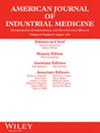Mortality of older construction and craft workers employed at Department of Energy (DOE) nuclear sites: Follow-up through 2021
Abstract
Background
To determine if construction and trades workers formerly employed at US Department of Energy (DOE) nuclear weapons sites are at significant risk for occupational diseases, we studied the mortality experience of participants in the Building Trades National Medical Screening Program (BTMed).
Methods
The cohort included 26,922 participants enrolled between 1998 and 2021 and 8367 deaths. Standardized mortality ratios were calculated based on US death rates. Cox models compared construction workers (n = 22,747; 7487 deaths) to two nonconstruction subpopulations: administrative, scientific and security workers (n = 1894; 330 deaths), and all other nonconstruction workers (n = 2218; 550 deaths).
Results
Mortality was elevated for all causes, all cancers, cancers of the trachea, bronchus, lung, kidneys, and lymphatic and hematopoietic system, mesothelioma, chronic obstructive pulmonary disease (COPD), asbestosis, transportation injuries, and other injuries, particularly accidental poisonings. There were 167 deaths from coronavirus disease 2019 (COVID-19), which was lower than expected using US death rates. Overall cause-specific mortality was significantly higher among construction workers than for internal comparison groups.
Conclusions
Construction workers employed at DOE sites have a significantly increased risk for occupational illnesses. Apart from COVID-19 deaths, this update: (1) found that mortality among construction workers is significantly elevated compared to the US population and significantly higher than in the internal comparison populations, and (2) confirmed excess risk for these workers for first employment after 1990. Cancer mortality risks are similar to the cancers identified for DOE compensation from radiation exposures. The high lung cancer risk supports the value of early lung cancer detection. Continued medical surveillance is important.

 求助内容:
求助内容: 应助结果提醒方式:
应助结果提醒方式:


